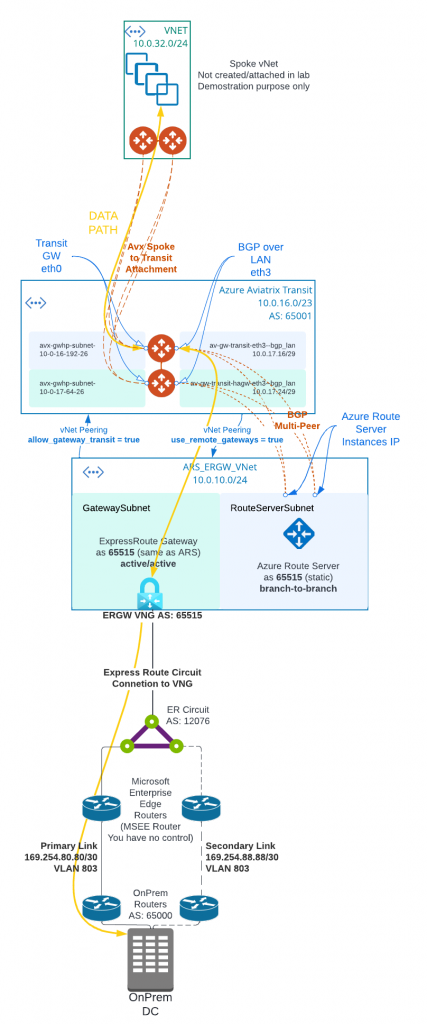In the last blog post: Express Route to Aviatrix Transit – Option 1, we have discussed how to use BGP over IPSec as overlay from customer on-premise devices to Aviatrix Transit Gateways. This solution have these two constrains:
- Each IPSec tunnel have 1.25G throughput limit
- Azure only support IPSec, not GRE as tunneling protocol
For customer have larger ExpressRoute circuit such as 5Gbps or 10Gbps and above, but doesn’t have encryption requirement or on-premise devices isn’t capable IPSec, option 1 isn’t ideal. In this blog, I will discuss the architecture to connect to Aviatrix Transit and utilize the full ExpressRoute bandwidth.
In following architecture diagram:
- Aviatrix Controller must be 6.8 and above to support Multi-Peer BGPoLAN for Azure Route Server. Azure Route Server require full-mesh peering to avoid single point of failure, which would result in black-hole in traffic flow.
- Aviatrix Transit Gateway must have Insane Mode (High Performance Encryption HPE) enabled, as well as BGP Over LAN enabled.
- Aviatrix Controller allows “Propagate gateway route”, only on the BGP over LAN interface subnet route table.
- The on-premise to ExpressRoute circuit private peering is similar to Express Route to Aviatrix Transit – Option 1
- Instead of deploying ExpressRoute Gateway (ERGW) inside of Aviatrix Transit vNet, we need to create a separate vNet to house ERGW and Azure Route Server (ARS)
- When native vNet peering been used between Spoke to Aviatrix Transit, if ARS is in the same Aviatrix Transit vNet, traffic from spoke to on-premise will bypass Aviatrix Transit gateway, as more specific route from on-premise will be inserted by ERGW point to ERGW, where Aviatrix programs less specific RFC1918 routes point to Aviatrix Transit
- This would apply also to HPE enabled Aviatrix Spoke, as when HPE is enabled, native vNet peering is been used as underlay to build multiple tunnels between Aviatrix Spoke Gateway to Aviatrix Transit Gateways.
- From Aviatrix Transit vNet created a vNet peering with ARS_ERGW_VNet, and enabled use_remote_gateways. This will enable ERGW to propagate learned route to Transit vNet
- From ARS_ERGW_VNet vNet created a vNet peering with Aviatrix Transit vNet, and enabled allow_gateway_transit.
- vNet peering is subject to $0.01 per GB for both inbound and outbound data transfer.
- Multi-hop eBGP is enabled between ARS and Aviatrix Transit Gateway
- ARS requires dedicated RouteServerSubnet subnet, /27 or above, cannot have UDR or Network Security Group (NSG) attached
- ERGW requires dedicated GatewaySubnet subnet, /27 or above, cannot have UDR or Network Security Group (NSG) attached
- Branch to Branch must be enabled on ARS to exchange routes between ARS and ERGW
- ARS Support 8 BGP peers, each peer support up to 1000 routes
- ARS can only exchange up to 200 routes with ERGW
- ARS is a route reflector, and it’s not in traffic path.
- ARS Cost: $0.45USD/hour or $324 USD per month, and for a service that’s not in data path, it’s not cheap
- When you create or delete an Azure Route Server from a virtual network that contains a Virtual Network Gateway (ExpressRoute or VPN), expect downtime until the operation complete. Reference Link

